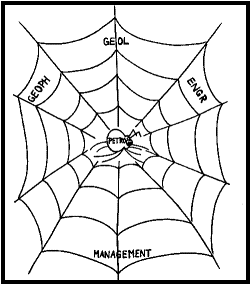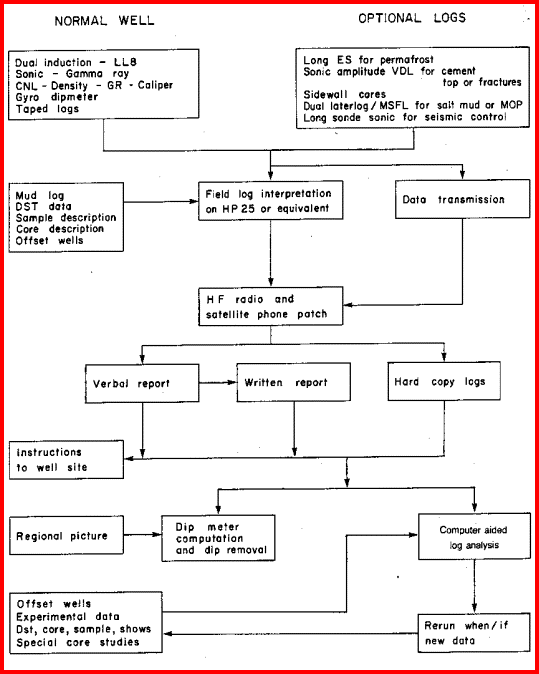Petrophysical Training
Licenses
|
 ROLE OF PETROPHYSICS and INTERACTIONS
ROLE OF PETROPHYSICS and INTERACTIONS
Petrophysicists offer services in the areas of well logging supervision,
log analysis and interpretation, integration of log data with
lab data, computer analysis of logs, seismic
modeling, synthetic seismograms, and reconciliations of log data
with geological, geophysical and exploration prospects, field
studies and simulations, reserves estimates, and submissions to
regulatory agencies.
These services are essential functions in
modern oil and gas companies and cannot be accomplished without
input from trained petrophysicists. The financial health and long-term
success of a company depends on the central role of the petrophysicist
in all aspects of the company’s exploration and development
activities.
Log analysis often requires some numerical exercise, especially
with the use of computers and calculators so common, but interpretation
and judgment calls are required from the analyst as well. The
job is not just to do the algebra, but, to decide what the numbers
really mean. Will the well produce oil, or gas, or water, how
much, and for how long?
 Mr.
G. E. Dawson-Grove, a well-known consulting
petrophysicist,
likens the role of the log analyst to that of the "spider
in the web." He claims that the petrophysicist plays a "vital,
central, potentially controlling position." The range of
his or her influence is wider than any other discipline within
the oil industry, with the possible exception of the financial
wizard. To be successful in this role, however, the analyst has
to realize the importance and potentially powerful position he
or she is in, and be able to sell ideas to co-workers and management. Mr.
G. E. Dawson-Grove, a well-known consulting
petrophysicist,
likens the role of the log analyst to that of the "spider
in the web." He claims that the petrophysicist plays a "vital,
central, potentially controlling position." The range of
his or her influence is wider than any other discipline within
the oil industry, with the possible exception of the financial
wizard. To be successful in this role, however, the analyst has
to realize the importance and potentially powerful position he
or she is in, and be able to sell ideas to co-workers and management.
Because of the multi-discipline approach required, the analyst
must maintain a web of communication with many seemingly unrelated
functions within the organization. The analyst must be sensitive
to the vibrations coming along each strand of the network and
respond accordingly. That response might be in the realm of geophysics,
geology, reservoir engineering, petroleum economics, secondary
or tertiary recovery engineering, or corporate management.
"D-G" goes on to explain that we should not consider
a response which suggests the minimum effort needed to get an
answer, but should emphasize the maximum contribution that a petrophysicist
(and all the available tools and data sets) could make to a company's
success. We must convince management that a "full evaluation"
is necessary, not just the minimum. There are selfish reasons
as well as altruistic ones to pursue this route. You will look
good if your company's success ratio looks good - especially if
you can show how your contribution helped.
 JOB DESCRIPTION - OFFICE DUTIES
JOB DESCRIPTION - OFFICE DUTIES
A
petrophysicist has many and varied duties. In the office, all of the
following could cross your desk:
1.
Design optimum logging programs, considering the objective
formations, fluid characteristics, and company budget.
2. Supervise computer analysis of new and old wells
to obtain maximum reconciliation of log data with cores,
drill stem tests, and geological sample descriptions,
using an in house system or commercial service bureaus
as required.
3. Control quality and turnaround time of computer analysis
jobs
4. Analyze dipmeter, production, and fracture identification
logs.
5. Analyze logs, by hand or by programmable calculator,
when computer analysis is impossible or inappropriate.
6. Co-ordinate log analysis for integration into reservoir
evaluations, reservoir model studies, or geophysical
prospects.
7. Undertake special research or in-depth studies of
particular problems, such as over-pressure, variable
log evaluation parameters, or exotic minerals.
8. Evaluate logs for ground water, coal, potash, salt,
tar sands, uranium, or other valuable resources.
9. Prepare and present log evaluation courses for general
or detailed study by oil company personnel.
10. Prepare detailed seismic models from well logs in
conjunction with stratigraphic or structural assumptions,
and create synthetic seismograms for each model using
a computerized system.
11. Attend well completion, drilling location, partner, and progress
meetings.
12. Supervise logistics of logging, coring, testing, and lab
operations.
 JOB DESCRIPTION - COMPUTER RELATED DUTIES
JOB DESCRIPTION - COMPUTER RELATED DUTIES
Using the petrophysical software package, duties could include
any of the following:
1.
Digitizer, magnetic tape, or keyboard data entry of
raw log data.
2. Edit data (re-scale, depth shift, point edit).
3. Enter and edit analysis parameters.
4. Permanent storage of data on disc or tape.
5. Prepare neat, printed results with input data and
computed data.
6. Prepare porosity and hydrocarbon volume accumulations
with or without cutoffs – detail or summary listings.
7. Handle metric or English units logs with equal ease.
8. Provide many different log analysis methods, with
user defined options, the choices depending on data
quality and formation characteristics.
9. Prepare four or three dimensional crossplots with
X, Y, Z and W axes and scales defined by the user.
10. Display versatile and highly selective plots of
results or input data or both, in colour.
11. Input, edit, averaging, printout and plotting of
core and mud log data and calibration of core and mud
log data with log curve data.
12. Create reservoir summaries sorted by zone, project
and cutoff levels.
13. Provide seismic data results (e.g. acoustic impedance,
velocity, integrated time or density) printed or plotted.
14. Prepare seismic model studies, including effect
of hydrocarbons and changing lithology.
15. Prepare synthetic seismograms on original or modeled
data, with variable wavelet type and frequency, and
create synthetic seismic section.
16. Provide fast turnaround, typically two hours for
one zone less than 300 feet thick. (Less time per zone
can be spent for multi-well or multi-zone projects).
Time will depend on log quality and type, availability
of other data, and whether or not that data is contradictory.
 JOB DESCRIPTION - FIELD DUTIES
JOB DESCRIPTION - FIELD DUTIES
Although travel to the field is less common now than in earlier
times, here is a list of possible tasks:
1.
Get to the rig on time.
2. Prepare for the job by studying prior work before
arrival, and by studying the sample description, DST
reports, core descriptions and well history after arrival.
3. Discuss well history and results to date with wellsite
geologist and drilling engineer.
4. Prepare instructions for the logging engineer as
thoroughly as possible, based on logging program in
well prognosis.
5. Discuss job details with logging engineer, explain
your special requirements, why you are there, and what
you expect from him.
6. Monitor progress continually; check films, repeats,
scales, calibrations, logging speeds, depth control,
keep records of tool failures, logging times, hole problems.
Do not rely solely on the logging engineer's data, opinions,
or service order information.
7. Monitor logistics, tool movements, hot-shots, time
commitments (aircraft, land sales, etc.).
8. Keep wellsite geologist, wellsite engineer, and drilling
supervisor informed on progress and problems, and keep
logging engineer informed of changing requirements and
time commitments.
9. Do log analysis based on all available data. Recommend
interesting intervals for testing, recommend additional
logs if analysis or log quality demands more data.
10. Report log analysis by radio or phone to oil company
home office, report progress and next moves to your
office via oil company contact or directly if radio
or phone time is available.
11. Monitor re-plays, film assembly, and field printing
of logs.
12. Write final reports, fill in all appropriate quality
control forms, and log analysis report forms.
13. Collect all films, tapes, and prints. Package for
hand delivery to client office, or arrange for air or
courier delivery of logs to oil company office (or to
partners as requested). No prints are to be left with
logging engineer unless authorized by the client.
14. Monitor and recommend parameters for computerized
field interpretations by the service company, if this
has been requested.
15. Set up zones for computer analysis. If required
make an extra set of logs for this, to be returned to
client with final computerized analysis.
16. Go to next job (or home), submit reports to your
office for typing, or finish report and email to office.
17. Check final typed report and deliver to client personally
(if possible).
18. Request log repairs, in writing, from service company,
or relay requirements to your office.
19. Request service company computed log (if required),
Supply parameters and quality control intermediate results
(or delegate to your office staff).
20. Supply copy of quality control report to service
company sales engineer and to service company location
manager.
21. Follow up results and recommendations with client.
22. Check logging contractor's service order for correct
and complete details. If you have signing authority,
sign service order and note discrepancies or disputes
for future handling.
23. Review final invoice from service company. Compare
to your own record of the job and request corrections
or approve for payment.

Flow of data from the wellsite
through to final analysis and interpretation. Note the
integration of offset data, core, DST and regional knowledge to
calibrate the results.
These duties are highly variable
over time and new situations occur at a moments notice. Be prepared!
|
|

